中考英语二轮专项复习课件 第06讲 介词
文档属性
| 名称 | 中考英语二轮专项复习课件 第06讲 介词 |  | |
| 格式 | pptx | ||
| 文件大小 | 1.8MB | ||
| 资源类型 | 试卷 | ||
| 版本资源 | 鲁教版 | ||
| 科目 | 英语 | ||
| 更新时间 | 2023-12-14 15:47:09 | ||
图片预览

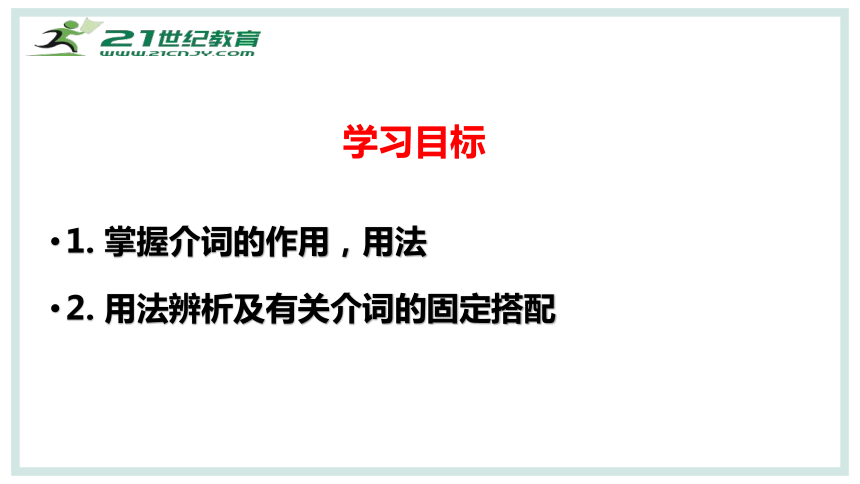
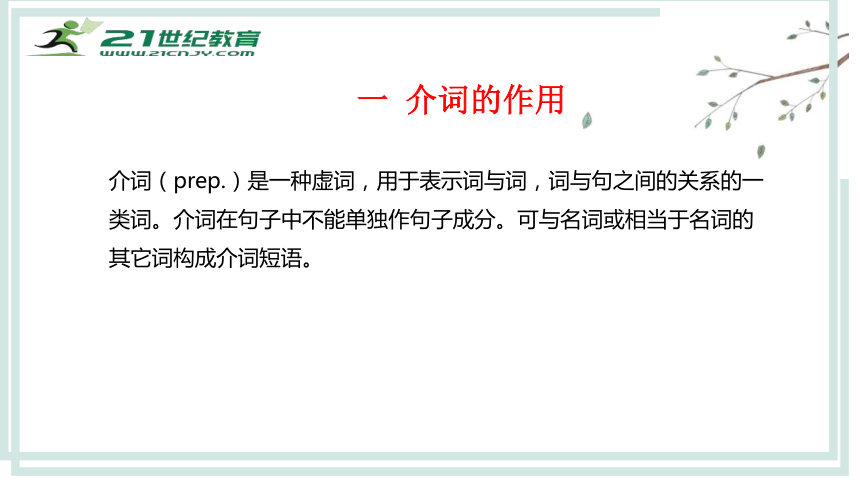
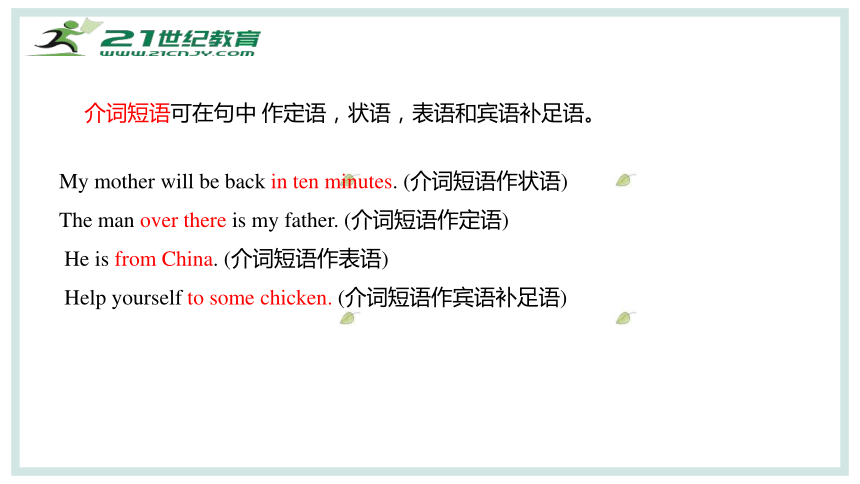

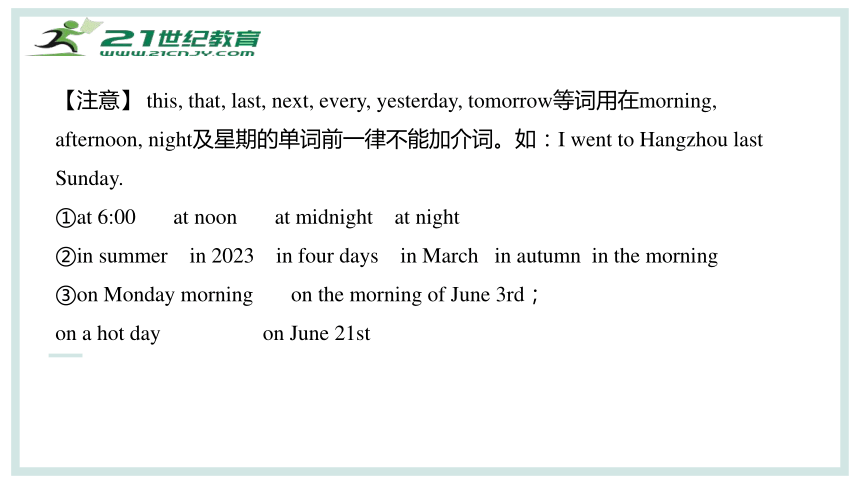

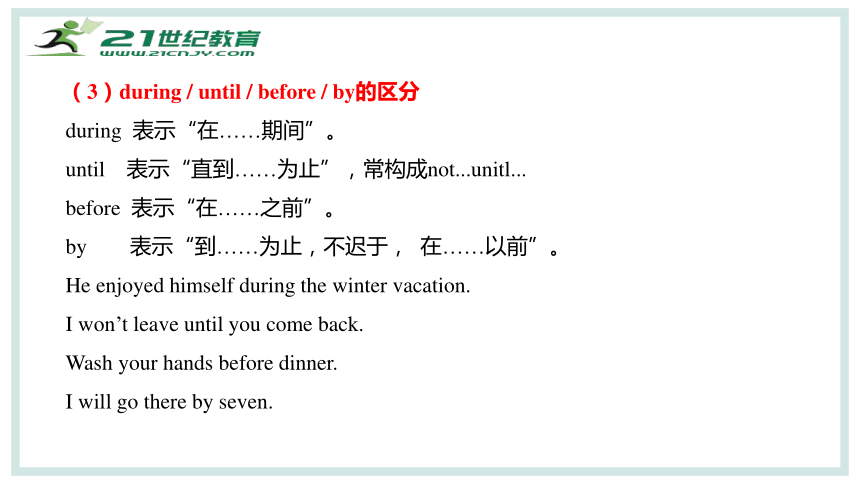
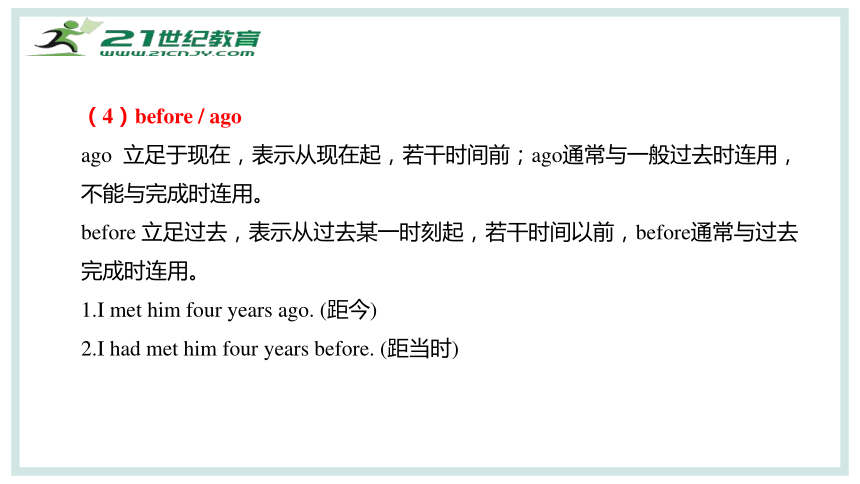

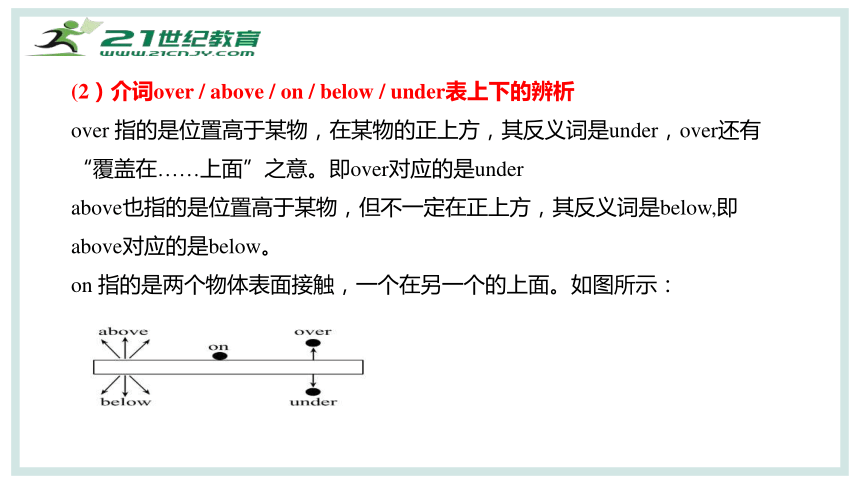
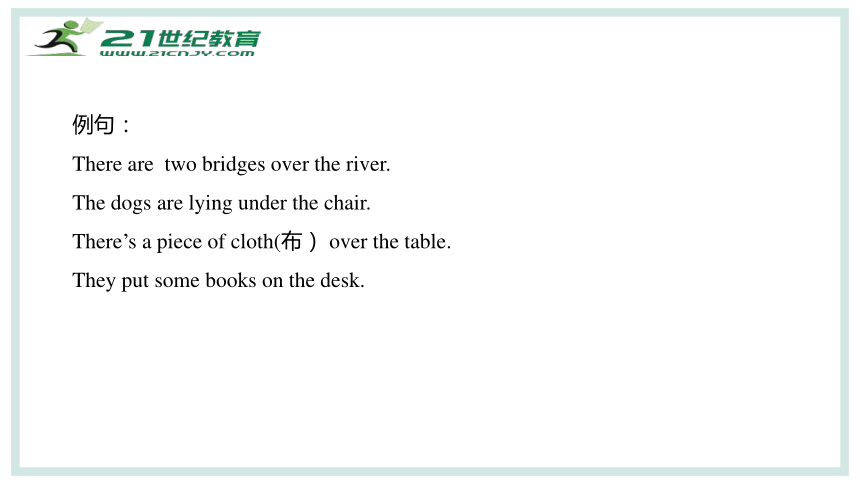
文档简介
(共50张PPT)
第六讲 介 词
中考英语专项复习
1. 掌握介词的作用,用法
2. 用法辨析及有关介词的固定搭配
学习目标
一 介词的作用
介词(prep.)是一种虚词,用于表示词与词,词与句之间的关系的一类词。介词在句子中不能单独作句子成分。可与名词或相当于名词的其它词构成介词短语。
介词短语可在句中 作定语,状语,表语和宾语补足语。
My mother will be back in ten minutes. (介词短语作状语)
The man over there is my father. (介词短语作定语)
He is from China. (介词短语作表语)
Help yourself to some chicken. (介词短语作宾语补足语)
二 常见介词及介词短语的用法辨析
1 表时间的介词
(1)at / in / on
at 用于某个时间点或黎明、正午、黄昏、午夜前。
in 用于在一段时间里(如:某个世纪,季节,某年,某月,上午,下午,晚上等)(在将来时句子中则表示在一段时间之后)。
on用于在具体的某一天或者某一天的某一段时间。
文本信息
标题数字等都可以通过点击和重新输入进行更改。文字数字大小颜色参考此模板
【注意】 this, that, last, next, every, yesterday, tomorrow等词用在morning, afternoon, night及星期的单词前一律不能加介词。如:I went to Hangzhou last Sunday.
①at 6:00 at noon at midnight at night
②in summer in 2023 in four days in March in autumn in the morning
③on Monday morning on the morning of June 3rd;
on a hot day on June 21st
(2)since / after / for
since 后加时间点或过去时的句子,表示“自从(过去某时)以来”。
after 后跟具体时刻,表示“在……时刻之后”,常用于将来时;
后跟时间段,多用于过去时。
for 后跟一段时间,表示“(持/延续)……之久”。
He has worked here since 2020.
He said that he would be here after 6:00.
We have lived here for two years.
(3)during / until / before / by的区分
during 表示“在……期间”。
until 表示“直到……为止”,常构成not...unitl...
before 表示“在……之前”。
by 表示“到……为止,不迟于, 在……以前”。
He enjoyed himself during the winter vacation.
I won’t leave until you come back.
Wash your hands before dinner.
I will go there by seven.
(4)before / ago
ago 立足于现在,表示从现在起,若干时间前;ago通常与一般过去时连用,不能与完成时连用。
before 立足过去,表示从过去某一时刻起,若干时间以前,before通常与过去完成时连用。
1.I met him four years ago. (距今)
2.I had met him four years before. (距当时)
2. 表示地点、方位的介词
(1)方位介词 at / in / on 加地点的用法辨析
at 用于较小的地方或用于门牌号码前
in 用于较大的地方或虽然是很小的地方,但人在里面也可用in。商店、学校、机关等,若看作一个地点(point)用at, 若看作一个场所(place)用in。
on 一般指与面或线接触(在某一层楼上), 意为“在……上;在……旁”。
He can wait for you at the station(车站). Tom lives at 108 Taishan Road.
He lives in Shanghai. Tom met her at the post-office.
He is working in the post-office now . The picture was hanging(挂) on the wall.
New York is on the Hudson River.
(2)介词over / above / on / below / under表上下的辨析
over 指的是位置高于某物,在某物的正上方,其反义词是under,over还有“覆盖在……上面”之意。即over对应的是under
above也指的是位置高于某物,但不一定在正上方,其反义词是below,即above对应的是below。
on 指的是两个物体表面接触,一个在另一个的上面。如图所示:
输入标题文本信息
标题数字等都可以通过点击和重新输入进行更改。文字数字大小颜色参考此模板
例句:
There are two bridges over the river.
The dogs are lying under the chair.
There’s a piece of cloth(布) over the table.
They put some books on the desk.
输入文本信息
点击此处输入文本信息。标题数字等都可以通过点击和重新输入进行更改,菜单设置中功能区可以对字体、字号、颜色、行距等进行修改。文字数字大小颜色参考此模板
(3)in / on / to作为方位名词的辨析
in 表示A地在B地的范围之内。
to 表示A地在B地范围的外面, 即二地之间有距离的间隔。
on 表示A地与B地是接壤、毗邻的关系。如图所示:
例句:.
Shandong is in the north of China.(在中国范围内)
Japan lies(位于) to the east of China. (两国不接壤)
North Korea(朝鲜) is on the east of China. (两国接壤)
(4)介词短语on the left / right of,表左右;介词beside / by表旁边;介词across / aross from表对面。
Tom sits beside/by me, just on my right. Tom坐在我旁边,正好在我右边。
There is a bankl right across the street. 街道对面就有一家银行
There is a school just arcoss from our house.
(5)in front of / in the front of / behind / before 表前后的意思辨析
in front of…“在……前面”,指甲物在乙物之前,两者互不包括, 其反义词是behind(在……的后面)。
in the front of “在……的前部”,即甲物在乙物的内部前面。反义词是at the back of…(在……范围内的后部)。
behind 表示在某个位置之后。
before表示“在……前面”,表示位置、次序或排列。
如图所示:
例句:
There is a trees in front of the house.
There is a blackboard in the front of our classroom.
There’s a flower bed(花坛) in front of the library and a swimming pool behind it.
Your name is before mine on the list.名单上你的名字在我之前
(6)in / inside / into / outside / out of 表里面外面的辨析
in 强调在……内部。
inside在……里面/向……里面(强调以……为界)内部,内侧, 反义词为outside在……外面。
into 到……里面,反义短语为out of。
The pencil is in my pencil box.
We are asked to stay inside the building at work.
Pour some milk into the blender.
点击此处
输入文本信息
(7)介词between / among 在...之间的辨析
between 在...中间,介于...之间。 用于二者之间,但是如果要表达三者或三者以上中的每两个之间的相互关系时,也要用between。
among 在...之中, 用于三者或三者以上之间。
I sat down between Joe and Diana.
The village lies between three hills.
He was among the last to leave. 他是最后离开者之一
She is the best among the students.
3. 表方式、手段、工具等介词by / with / in / on的辨析
(1)by表示通过某种方式或手段。后加名词时,不加冠词,即by+名词。后加动词,要加动名词形式,即by +动词ing。
(2)by, in, on表交通方式:用by时,交通工具前不用任何限定词;用on或in时,交通工具前用限定词。
(3)with表示“用”某种工具,身体的某一部位或器官。
(4)in+语言类名词或工具的具体类型,语言、工具前不加冠词。如:
on+网络/电脑/电视/电话/收音机/大米/脚等。意思是“通过/用/以(网络/电脑/电视/电话/收音机等)方式”。
点击此处
输入文本信息
例句:
The T-shirt must be washed by hand. (手洗 hand前不用加the
Jim goes to school by bike. (注意by bike=on a bike)
He goes to work by car. (注意by car=in a car)
Cut the apple with a knife.
I can spell the words in English
Tom will get the news on the radio.
She often goes to school on foot.
点击此处
输入文本信息
4. 其它常见介词的辨析
(1)across / through表示“通过,穿过”时的辨析。
across “横过,穿过”,指的是从物体表面的一边到另一边。
through“ 穿过,贯穿,通过”,指从某一物体空间内通过。
Go across the street and you will see a bank.
It is too wide. We can not swim acros
The doctor pushed his way through the crowd (挤过人群)
He ran through the door.
点击此处
输入文本信息
(2)besides / except / except for / but 表示“除……外”时的用法辨析。
besides “除了……以外,还有……,除....之外(还)”,具有附加性质,还包括在内。
【注意】besides用于否定句中时,与except, but同义,可互换。
如:We have no other books besides / except these.
except “……除外”,具有排它性质,不包括在内。
except for “除了……”,即表示除去整体中的一部分。
but “除了”,与except同义,except强调被排除的部分,
but则强调整句的内容,常修饰否定意义的代词。
点击此处
输入文本信息
例句
Besides Mr White, we also went to the cinema.(也去了)
We all went to the cinema except Mr White.(没去)
The article is very good except for a few spelling mistakes.
I had no choice but to sign the contract(合同)。
There is nothing but a card in the box.
点击此处
输入文本信息
(3)near / by / beside / at表示“在……附近”时的用法辨析。
near “在……附近”表示相对的近,实际距离可能还很远。
at “在……旁边”但多表示有目的的行为所处的位置,而by和beside仅表位置关系。
by “在……近旁” 比near表示的距离近。
beside “在……旁边”表示紧挨着。
by 和 beside都表示靠近,实际距离不可能很远,但beside比by更具体地表示出“在……旁边”之意。
点击此处
输入文本信息
例句:
The students are sitting at the desks listening to the teacher.
Tom was sitting at the table by the window.
He is sitting beside his grandpa.
(4)on / about表示“关于”时的用法辨析
on 学术性、论述性的“关于”。
about 涉猎性的“关于”指泛泛地或非正式地谈论某事,其谈论的内容也较为普通。
It is a book on dogs. 那是一本论述狗的书。(可能是学术著作)
It is a book about dogs. 那是一本关于狗的书。(可能是供小孩看的故事书)
点击此处
输入文本信息
(5)in the tree / on the tree表示“在树上”时的用法辨析
in the tree 指动物或人在树上。 on the tree 指果实、树叶长在树上。
There is a cat in the tree.
There are many apples on the apple tree.
(6)like / as表示“像……一样”时的用法辨析
like意为“像……一样”,用于说明相似关系,实际上不是。如:
She talked to me like my mother. (实际上不是我父亲,但像父亲一样)
as用作连词时,意为“像……一样”, as用作介词时,意为“作为,以……的身份”,后跟表示职业、职务的名词。
She talked to me as a motehr. 以母亲的身份跟我说话。(就是我母亲)
点击此处
输入文本信息
(7)under / with / in表示“在……下”时的用法辨析
under 在……(管理,运营,影响)下 如 under control
with 在……(帮助下)如 with the help of sb 或with sb’s help
in 在(阳光)下
She has a staff of 19 working under her(有19个员工在她手下工作)
Don’t read in the sun, please.
With her help, I finished my work.
(8)with / without表示伴随时的用法辨析
with 表伴随时 “和……一起” 用作状语,
without 表伴随时 意为“没有” 用作状语。
点击此处
输入文本信息
(9)in / into 在/到……里面时, on/onto 在/到……上面的用法辨析
in 在……里面 表示状态 into 往/到……里面 表示动作。
on 在……上面 表示状态 onto 往/到……上面 表示动作。
I putta ruler into her pencil box.
The cat jumped onto the horse.
(10)after / behind表示“在……后面”时的用法辨析
after“在……之面”,指时间和顺序, behind“在……后面”,表示位置。
He came to see Tom’s father after three weeks.
He stood behind me.
(11)to / towards / for表示“到/往/朝/去/向……”时的用法辨析
to 到 ,往 强调目的地,多用于come, go, return, move等动词后。
towards 朝,向 表示方向,含有没有到达之意。
for 去,往表示方向,多用于leave, start等动词后。
He moved to Beijing last year.
Tom walked towards his house.
I left for Paris yesterday
(11)of/ to/ for表示“……的”时的用法辨析
of 表示“……的” 表示所属关系。
to 表示“……的” 表示对于、通向。
for 表示“……的”表示用途。
This is a map of China.
Please give me the key to the door.
I want to buy three tickets for the concert.
(12)of sb. / for sb.表示“对于(某人)”时的用法辨析
of sb.“对于(某人)”用于“It is+adj.+of sb. +to do sth.”句型中,
形容词为clever, kind, nice, good, polite, foolish, lazy, careful, careless, right, wrong等描述人物性格、品质特征的词,of后的人物与形容词有主表关系。
for sb.“对于(某人)”用于“It is+adj.+for sb. +to do sth.”句型中,形容词为easy, important, hard, difficult, necessary, dangerous, safe, useful, pleasant, interesting, impossible等描述事物特征的词,for后的人物与形容词没有主表关系。
例句:
1.It’s very kind of you to help me with my math.
2.It’s difficult for me to finish the work by myself.
(13) 使用介词时应注意的问题
时间介词的省略。在this/that/these/those/last/next/a/every/each/one/all等词构成的时间短语前,一般不用at, in, on。
如:Every year visitors come to visit Tai'an.
I want to buy a book tomorrow.
在某些名词词组前,可以省略(也可不省)如:(on) that day, (in)the year
如:He said that he helped an old man cross the street that day.
(14)介词有时会与它的宾语分离,这时候介词的宾语放在了前面,即宾语前置。
①如当宾语是疑问词时。
如:Who are you talking about about的宾语who前置
②当介词的宾语在从句中当连接词时,注意后面的介词短语的完整性。
如:He has a younger sister who (作宾语)he must take good care of.
Do you know who(作宾语) our fatheris talking with over there
③动词不定式作定语且该动词为不及物动词,后面的介词要注意。
如:I finally found a chair to sit on.
三、介词的固定搭配
介词通常会同其他词类组合,形成了固定搭配关系。
1. 介词短语在句子中的位置。
介词短语做状语时,表示时间/地点,可以放在句首或句尾,
表示方向/方式/伴随/涉及/原因/目的/比较,一般放在句尾;
介词短语作表语时放在连系动词之后;
介词短语作定语时,只能放在被修饰的名词之后。
如:He wanted to find a good job in Shanghai the next year. (状语)
The letters are for you. (表语) // Have you seen a cat with a black head and four white legs (定语)
例句:
Tom wanted to find a good job in Shandong next year. (地点状语)
I am with you. (作表语)
Have you seen a dog with a white head and four black legs (作定语)
2 动词+介词 结构常见固定搭配
A: agree with同意 arrive in/at 到达 ask for请求;
B: begin with 以……开始 belong to 属于;
C: call on 号召,访问,邀请;
D: deal (do) with 处置,对待 depend on 依赖,依靠 die of (from)死于
do well in在……方面做得好;
F: fill with 充满,装满;
G: get to到达 give up 放弃;
H: hand in上交;hear from 收到……的来信 hear of 听说;
help…with 帮助;
L: laugh at嘲笑;learn from向……学习;leave for出发去某地;listen on 听……;look at (有意识地)看;look after照顾,照看;look for寻找;look like看上去像;look about/around四下看,到处看;
P: pay for (sth.) 付(……)钱,支付(……费用);pass on 传递;point to指着;
put on穿上;prefer…to… 宁愿选择……,
R: regard…as… 把……看作……;
S: send for 派人去叫,叫人去拿;shout at大声叫喊,吼叫;smile at向……微笑;
speak to对……说;
T: take away拿走,带走;take down拿下,取下;take off脱下,起飞;
talk to与……谈话;thanks to 幸亏,由于;think about 考虑;think of考虑,关心;try on试穿(衣服,鞋等);turn...into... 把……变成……;turn on (off)打开(关上);turn up (down) 开大(关小);
W: wait for 等候,等待;write to写信给……
2. 介词+名词 结构常见的固定搭配
A
at all 根本,全然;at home 在家;at dinner 在吃正餐;at first 首先,
at hospital 在医院;at last最后,终于;at least 至少;at night 在晚上;
at noon 在中午;at once 立刻,马上;at school在学校;at sea 在大海上;
at work 在工作;at the age of 在……岁时;at the back of 在……后面;at the end of 在……结尾;at the foot of 在……脚下;at the meeting 在会上;
at the same time 同时,然而;at the table 在桌子旁;
B
by hand用手,手工,亲手;by the end of 到……结束时;
by the time... 到……的时候;by the way顺便说说(问问);
by bus乘公共汽车;by train 乘火车;
D
day by day 日复一日;
I
in a hurry匆忙,急忙;in a low voice小声地;in a minute 一会儿;
in a short while 不久; in a word总而言之,一句话;in bed 卧床;
in English用英语;in fact事实上;in front of在……前面;
in life 一生中;in no time立刻,很快;
in all总共,总计;in line成直线;in order按顺序,整齐,正常;
in order to为了,以便;
in public当众,公开地;in space 在空间;in surprise惊奇地;
in time 及时;in town在城里;in trouble处于困境;
in silence不作声;in this way用这种方法;
in the air 在空中;in the distance 在远处;in the end最后,终于;
in the day在白天;
in the middle of 在中间;in the sun在阳光下;in the tree在树上;
O
on foot 步行;on one’s way to 在某人去……的路上;on time 准时,按时;of course 当然(可以);on display 陈列,展览;on duty 值日;one by one 一个接一个;
on the earth 在地球上;on show 展出;on the left (right) 在左(右)边;
on the radio 通过无线电广播;on top of... 在……顶上;out of breath 上气不接下气;out of sight 消失,看不见;out of work失业;
to this day 直到今天;to one’s surprise (joy) 使某人吃惊(高兴)的是;
with a smile 带着微笑
3. 介词与形容词、过去分词和动词等构成的常见固定搭配
be angry at sth. 为某事生气 be angry with sb. 跟某人生气;
be busy with... 忙于……; be born in ... 出生于……;
be full of... 充满……; be good at… 擅长……;
be interested in 对……感兴趣;
be made of... 由……制成(物理变化)be made from... 由……制成(化学变化);
be pleased with sb. 对某人感到满意;be proud of... 以……为自豪(骄傲);
be satisfied with sth. 对某事感到满意;
be strict with sb. 对某人严格要求; be sure of... 确信……;
be surprised at 对……感到惊奇(诧异);be tired of… 讨厌……,厌烦……;
be used to... 习惯于……;
break into (in)闯入;cath up with跟上,赶上;go to school去上学;
go to bed (sleep)去睡觉;go to the cinema 去看电影;
have nothing to do with… 与……无关;look forward to盼望,期待;
keep out of不让进入;say hello to 向……问好;
take care of照顾,关心,保管;take (catch) hold of 抓住;take part in 参加;
四 实 战 演 练
1. The thief walked the street, jumped a tall wall and ran away.
A. through; across B. across; over C. over; across
2. You can improve your English practising more.
A. by B. with C. of
3. The foreigners arrived Shanghai late night.
A. at; at B. in; at C. in; in
B
A
B
4.(2023·湖北十堰·统考中考真题)—________ my surprise, the restaurant is a actually very nice.
—The service is also great.
A.In B.At C.On D.To
D
5.(2023·江苏无锡·统考中考真题)A new bridge was built ________ the Yellow River last year.
A.around B.across C.against D.along
B
谢谢
21世纪教育网(www.21cnjy.com)
中小学教育资源网站
兼职招聘:
https://www.21cnjy.com/recruitment/home/admin
第六讲 介 词
中考英语专项复习
1. 掌握介词的作用,用法
2. 用法辨析及有关介词的固定搭配
学习目标
一 介词的作用
介词(prep.)是一种虚词,用于表示词与词,词与句之间的关系的一类词。介词在句子中不能单独作句子成分。可与名词或相当于名词的其它词构成介词短语。
介词短语可在句中 作定语,状语,表语和宾语补足语。
My mother will be back in ten minutes. (介词短语作状语)
The man over there is my father. (介词短语作定语)
He is from China. (介词短语作表语)
Help yourself to some chicken. (介词短语作宾语补足语)
二 常见介词及介词短语的用法辨析
1 表时间的介词
(1)at / in / on
at 用于某个时间点或黎明、正午、黄昏、午夜前。
in 用于在一段时间里(如:某个世纪,季节,某年,某月,上午,下午,晚上等)(在将来时句子中则表示在一段时间之后)。
on用于在具体的某一天或者某一天的某一段时间。
文本信息
标题数字等都可以通过点击和重新输入进行更改。文字数字大小颜色参考此模板
【注意】 this, that, last, next, every, yesterday, tomorrow等词用在morning, afternoon, night及星期的单词前一律不能加介词。如:I went to Hangzhou last Sunday.
①at 6:00 at noon at midnight at night
②in summer in 2023 in four days in March in autumn in the morning
③on Monday morning on the morning of June 3rd;
on a hot day on June 21st
(2)since / after / for
since 后加时间点或过去时的句子,表示“自从(过去某时)以来”。
after 后跟具体时刻,表示“在……时刻之后”,常用于将来时;
后跟时间段,多用于过去时。
for 后跟一段时间,表示“(持/延续)……之久”。
He has worked here since 2020.
He said that he would be here after 6:00.
We have lived here for two years.
(3)during / until / before / by的区分
during 表示“在……期间”。
until 表示“直到……为止”,常构成not...unitl...
before 表示“在……之前”。
by 表示“到……为止,不迟于, 在……以前”。
He enjoyed himself during the winter vacation.
I won’t leave until you come back.
Wash your hands before dinner.
I will go there by seven.
(4)before / ago
ago 立足于现在,表示从现在起,若干时间前;ago通常与一般过去时连用,不能与完成时连用。
before 立足过去,表示从过去某一时刻起,若干时间以前,before通常与过去完成时连用。
1.I met him four years ago. (距今)
2.I had met him four years before. (距当时)
2. 表示地点、方位的介词
(1)方位介词 at / in / on 加地点的用法辨析
at 用于较小的地方或用于门牌号码前
in 用于较大的地方或虽然是很小的地方,但人在里面也可用in。商店、学校、机关等,若看作一个地点(point)用at, 若看作一个场所(place)用in。
on 一般指与面或线接触(在某一层楼上), 意为“在……上;在……旁”。
He can wait for you at the station(车站). Tom lives at 108 Taishan Road.
He lives in Shanghai. Tom met her at the post-office.
He is working in the post-office now . The picture was hanging(挂) on the wall.
New York is on the Hudson River.
(2)介词over / above / on / below / under表上下的辨析
over 指的是位置高于某物,在某物的正上方,其反义词是under,over还有“覆盖在……上面”之意。即over对应的是under
above也指的是位置高于某物,但不一定在正上方,其反义词是below,即above对应的是below。
on 指的是两个物体表面接触,一个在另一个的上面。如图所示:
输入标题文本信息
标题数字等都可以通过点击和重新输入进行更改。文字数字大小颜色参考此模板
例句:
There are two bridges over the river.
The dogs are lying under the chair.
There’s a piece of cloth(布) over the table.
They put some books on the desk.
输入文本信息
点击此处输入文本信息。标题数字等都可以通过点击和重新输入进行更改,菜单设置中功能区可以对字体、字号、颜色、行距等进行修改。文字数字大小颜色参考此模板
(3)in / on / to作为方位名词的辨析
in 表示A地在B地的范围之内。
to 表示A地在B地范围的外面, 即二地之间有距离的间隔。
on 表示A地与B地是接壤、毗邻的关系。如图所示:
例句:.
Shandong is in the north of China.(在中国范围内)
Japan lies(位于) to the east of China. (两国不接壤)
North Korea(朝鲜) is on the east of China. (两国接壤)
(4)介词短语on the left / right of,表左右;介词beside / by表旁边;介词across / aross from表对面。
Tom sits beside/by me, just on my right. Tom坐在我旁边,正好在我右边。
There is a bankl right across the street. 街道对面就有一家银行
There is a school just arcoss from our house.
(5)in front of / in the front of / behind / before 表前后的意思辨析
in front of…“在……前面”,指甲物在乙物之前,两者互不包括, 其反义词是behind(在……的后面)。
in the front of “在……的前部”,即甲物在乙物的内部前面。反义词是at the back of…(在……范围内的后部)。
behind 表示在某个位置之后。
before表示“在……前面”,表示位置、次序或排列。
如图所示:
例句:
There is a trees in front of the house.
There is a blackboard in the front of our classroom.
There’s a flower bed(花坛) in front of the library and a swimming pool behind it.
Your name is before mine on the list.名单上你的名字在我之前
(6)in / inside / into / outside / out of 表里面外面的辨析
in 强调在……内部。
inside在……里面/向……里面(强调以……为界)内部,内侧, 反义词为outside在……外面。
into 到……里面,反义短语为out of。
The pencil is in my pencil box.
We are asked to stay inside the building at work.
Pour some milk into the blender.
点击此处
输入文本信息
(7)介词between / among 在...之间的辨析
between 在...中间,介于...之间。 用于二者之间,但是如果要表达三者或三者以上中的每两个之间的相互关系时,也要用between。
among 在...之中, 用于三者或三者以上之间。
I sat down between Joe and Diana.
The village lies between three hills.
He was among the last to leave. 他是最后离开者之一
She is the best among the students.
3. 表方式、手段、工具等介词by / with / in / on的辨析
(1)by表示通过某种方式或手段。后加名词时,不加冠词,即by+名词。后加动词,要加动名词形式,即by +动词ing。
(2)by, in, on表交通方式:用by时,交通工具前不用任何限定词;用on或in时,交通工具前用限定词。
(3)with表示“用”某种工具,身体的某一部位或器官。
(4)in+语言类名词或工具的具体类型,语言、工具前不加冠词。如:
on+网络/电脑/电视/电话/收音机/大米/脚等。意思是“通过/用/以(网络/电脑/电视/电话/收音机等)方式”。
点击此处
输入文本信息
例句:
The T-shirt must be washed by hand. (手洗 hand前不用加the
Jim goes to school by bike. (注意by bike=on a bike)
He goes to work by car. (注意by car=in a car)
Cut the apple with a knife.
I can spell the words in English
Tom will get the news on the radio.
She often goes to school on foot.
点击此处
输入文本信息
4. 其它常见介词的辨析
(1)across / through表示“通过,穿过”时的辨析。
across “横过,穿过”,指的是从物体表面的一边到另一边。
through“ 穿过,贯穿,通过”,指从某一物体空间内通过。
Go across the street and you will see a bank.
It is too wide. We can not swim acros
The doctor pushed his way through the crowd (挤过人群)
He ran through the door.
点击此处
输入文本信息
(2)besides / except / except for / but 表示“除……外”时的用法辨析。
besides “除了……以外,还有……,除....之外(还)”,具有附加性质,还包括在内。
【注意】besides用于否定句中时,与except, but同义,可互换。
如:We have no other books besides / except these.
except “……除外”,具有排它性质,不包括在内。
except for “除了……”,即表示除去整体中的一部分。
but “除了”,与except同义,except强调被排除的部分,
but则强调整句的内容,常修饰否定意义的代词。
点击此处
输入文本信息
例句
Besides Mr White, we also went to the cinema.(也去了)
We all went to the cinema except Mr White.(没去)
The article is very good except for a few spelling mistakes.
I had no choice but to sign the contract(合同)。
There is nothing but a card in the box.
点击此处
输入文本信息
(3)near / by / beside / at表示“在……附近”时的用法辨析。
near “在……附近”表示相对的近,实际距离可能还很远。
at “在……旁边”但多表示有目的的行为所处的位置,而by和beside仅表位置关系。
by “在……近旁” 比near表示的距离近。
beside “在……旁边”表示紧挨着。
by 和 beside都表示靠近,实际距离不可能很远,但beside比by更具体地表示出“在……旁边”之意。
点击此处
输入文本信息
例句:
The students are sitting at the desks listening to the teacher.
Tom was sitting at the table by the window.
He is sitting beside his grandpa.
(4)on / about表示“关于”时的用法辨析
on 学术性、论述性的“关于”。
about 涉猎性的“关于”指泛泛地或非正式地谈论某事,其谈论的内容也较为普通。
It is a book on dogs. 那是一本论述狗的书。(可能是学术著作)
It is a book about dogs. 那是一本关于狗的书。(可能是供小孩看的故事书)
点击此处
输入文本信息
(5)in the tree / on the tree表示“在树上”时的用法辨析
in the tree 指动物或人在树上。 on the tree 指果实、树叶长在树上。
There is a cat in the tree.
There are many apples on the apple tree.
(6)like / as表示“像……一样”时的用法辨析
like意为“像……一样”,用于说明相似关系,实际上不是。如:
She talked to me like my mother. (实际上不是我父亲,但像父亲一样)
as用作连词时,意为“像……一样”, as用作介词时,意为“作为,以……的身份”,后跟表示职业、职务的名词。
She talked to me as a motehr. 以母亲的身份跟我说话。(就是我母亲)
点击此处
输入文本信息
(7)under / with / in表示“在……下”时的用法辨析
under 在……(管理,运营,影响)下 如 under control
with 在……(帮助下)如 with the help of sb 或with sb’s help
in 在(阳光)下
She has a staff of 19 working under her(有19个员工在她手下工作)
Don’t read in the sun, please.
With her help, I finished my work.
(8)with / without表示伴随时的用法辨析
with 表伴随时 “和……一起” 用作状语,
without 表伴随时 意为“没有” 用作状语。
点击此处
输入文本信息
(9)in / into 在/到……里面时, on/onto 在/到……上面的用法辨析
in 在……里面 表示状态 into 往/到……里面 表示动作。
on 在……上面 表示状态 onto 往/到……上面 表示动作。
I putta ruler into her pencil box.
The cat jumped onto the horse.
(10)after / behind表示“在……后面”时的用法辨析
after“在……之面”,指时间和顺序, behind“在……后面”,表示位置。
He came to see Tom’s father after three weeks.
He stood behind me.
(11)to / towards / for表示“到/往/朝/去/向……”时的用法辨析
to 到 ,往 强调目的地,多用于come, go, return, move等动词后。
towards 朝,向 表示方向,含有没有到达之意。
for 去,往表示方向,多用于leave, start等动词后。
He moved to Beijing last year.
Tom walked towards his house.
I left for Paris yesterday
(11)of/ to/ for表示“……的”时的用法辨析
of 表示“……的” 表示所属关系。
to 表示“……的” 表示对于、通向。
for 表示“……的”表示用途。
This is a map of China.
Please give me the key to the door.
I want to buy three tickets for the concert.
(12)of sb. / for sb.表示“对于(某人)”时的用法辨析
of sb.“对于(某人)”用于“It is+adj.+of sb. +to do sth.”句型中,
形容词为clever, kind, nice, good, polite, foolish, lazy, careful, careless, right, wrong等描述人物性格、品质特征的词,of后的人物与形容词有主表关系。
for sb.“对于(某人)”用于“It is+adj.+for sb. +to do sth.”句型中,形容词为easy, important, hard, difficult, necessary, dangerous, safe, useful, pleasant, interesting, impossible等描述事物特征的词,for后的人物与形容词没有主表关系。
例句:
1.It’s very kind of you to help me with my math.
2.It’s difficult for me to finish the work by myself.
(13) 使用介词时应注意的问题
时间介词的省略。在this/that/these/those/last/next/a/every/each/one/all等词构成的时间短语前,一般不用at, in, on。
如:Every year visitors come to visit Tai'an.
I want to buy a book tomorrow.
在某些名词词组前,可以省略(也可不省)如:(on) that day, (in)the year
如:He said that he helped an old man cross the street that day.
(14)介词有时会与它的宾语分离,这时候介词的宾语放在了前面,即宾语前置。
①如当宾语是疑问词时。
如:Who are you talking about about的宾语who前置
②当介词的宾语在从句中当连接词时,注意后面的介词短语的完整性。
如:He has a younger sister who (作宾语)he must take good care of.
Do you know who(作宾语) our fatheris talking with over there
③动词不定式作定语且该动词为不及物动词,后面的介词要注意。
如:I finally found a chair to sit on.
三、介词的固定搭配
介词通常会同其他词类组合,形成了固定搭配关系。
1. 介词短语在句子中的位置。
介词短语做状语时,表示时间/地点,可以放在句首或句尾,
表示方向/方式/伴随/涉及/原因/目的/比较,一般放在句尾;
介词短语作表语时放在连系动词之后;
介词短语作定语时,只能放在被修饰的名词之后。
如:He wanted to find a good job in Shanghai the next year. (状语)
The letters are for you. (表语) // Have you seen a cat with a black head and four white legs (定语)
例句:
Tom wanted to find a good job in Shandong next year. (地点状语)
I am with you. (作表语)
Have you seen a dog with a white head and four black legs (作定语)
2 动词+介词 结构常见固定搭配
A: agree with同意 arrive in/at 到达 ask for请求;
B: begin with 以……开始 belong to 属于;
C: call on 号召,访问,邀请;
D: deal (do) with 处置,对待 depend on 依赖,依靠 die of (from)死于
do well in在……方面做得好;
F: fill with 充满,装满;
G: get to到达 give up 放弃;
H: hand in上交;hear from 收到……的来信 hear of 听说;
help…with 帮助;
L: laugh at嘲笑;learn from向……学习;leave for出发去某地;listen on 听……;look at (有意识地)看;look after照顾,照看;look for寻找;look like看上去像;look about/around四下看,到处看;
P: pay for (sth.) 付(……)钱,支付(……费用);pass on 传递;point to指着;
put on穿上;prefer…to… 宁愿选择……,
R: regard…as… 把……看作……;
S: send for 派人去叫,叫人去拿;shout at大声叫喊,吼叫;smile at向……微笑;
speak to对……说;
T: take away拿走,带走;take down拿下,取下;take off脱下,起飞;
talk to与……谈话;thanks to 幸亏,由于;think about 考虑;think of考虑,关心;try on试穿(衣服,鞋等);turn...into... 把……变成……;turn on (off)打开(关上);turn up (down) 开大(关小);
W: wait for 等候,等待;write to写信给……
2. 介词+名词 结构常见的固定搭配
A
at all 根本,全然;at home 在家;at dinner 在吃正餐;at first 首先,
at hospital 在医院;at last最后,终于;at least 至少;at night 在晚上;
at noon 在中午;at once 立刻,马上;at school在学校;at sea 在大海上;
at work 在工作;at the age of 在……岁时;at the back of 在……后面;at the end of 在……结尾;at the foot of 在……脚下;at the meeting 在会上;
at the same time 同时,然而;at the table 在桌子旁;
B
by hand用手,手工,亲手;by the end of 到……结束时;
by the time... 到……的时候;by the way顺便说说(问问);
by bus乘公共汽车;by train 乘火车;
D
day by day 日复一日;
I
in a hurry匆忙,急忙;in a low voice小声地;in a minute 一会儿;
in a short while 不久; in a word总而言之,一句话;in bed 卧床;
in English用英语;in fact事实上;in front of在……前面;
in life 一生中;in no time立刻,很快;
in all总共,总计;in line成直线;in order按顺序,整齐,正常;
in order to为了,以便;
in public当众,公开地;in space 在空间;in surprise惊奇地;
in time 及时;in town在城里;in trouble处于困境;
in silence不作声;in this way用这种方法;
in the air 在空中;in the distance 在远处;in the end最后,终于;
in the day在白天;
in the middle of 在中间;in the sun在阳光下;in the tree在树上;
O
on foot 步行;on one’s way to 在某人去……的路上;on time 准时,按时;of course 当然(可以);on display 陈列,展览;on duty 值日;one by one 一个接一个;
on the earth 在地球上;on show 展出;on the left (right) 在左(右)边;
on the radio 通过无线电广播;on top of... 在……顶上;out of breath 上气不接下气;out of sight 消失,看不见;out of work失业;
to this day 直到今天;to one’s surprise (joy) 使某人吃惊(高兴)的是;
with a smile 带着微笑
3. 介词与形容词、过去分词和动词等构成的常见固定搭配
be angry at sth. 为某事生气 be angry with sb. 跟某人生气;
be busy with... 忙于……; be born in ... 出生于……;
be full of... 充满……; be good at… 擅长……;
be interested in 对……感兴趣;
be made of... 由……制成(物理变化)be made from... 由……制成(化学变化);
be pleased with sb. 对某人感到满意;be proud of... 以……为自豪(骄傲);
be satisfied with sth. 对某事感到满意;
be strict with sb. 对某人严格要求; be sure of... 确信……;
be surprised at 对……感到惊奇(诧异);be tired of… 讨厌……,厌烦……;
be used to... 习惯于……;
break into (in)闯入;cath up with跟上,赶上;go to school去上学;
go to bed (sleep)去睡觉;go to the cinema 去看电影;
have nothing to do with… 与……无关;look forward to盼望,期待;
keep out of不让进入;say hello to 向……问好;
take care of照顾,关心,保管;take (catch) hold of 抓住;take part in 参加;
四 实 战 演 练
1. The thief walked the street, jumped a tall wall and ran away.
A. through; across B. across; over C. over; across
2. You can improve your English practising more.
A. by B. with C. of
3. The foreigners arrived Shanghai late night.
A. at; at B. in; at C. in; in
B
A
B
4.(2023·湖北十堰·统考中考真题)—________ my surprise, the restaurant is a actually very nice.
—The service is also great.
A.In B.At C.On D.To
D
5.(2023·江苏无锡·统考中考真题)A new bridge was built ________ the Yellow River last year.
A.around B.across C.against D.along
B
谢谢
21世纪教育网(www.21cnjy.com)
中小学教育资源网站
兼职招聘:
https://www.21cnjy.com/recruitment/home/admin
同课章节目录
- 词法
- 名词
- 动词和动词短语
- 动词语态
- 动词时态
- 助动词和情态动词
- 非谓语动词
- 冠词
- 代词
- 数词和量词
- 形容词副词及其比较等级
- 介词和介词短语
- 连词和感叹词
- 构词法
- 相似、相近词比较
- 句法
- 陈述句
- 一般疑问句和否定疑问句
- 特殊疑问句及选择疑问句
- 反意疑问句
- 存在句(There be句型)
- 宾语从句
- 定语从句
- 状语从句
- 主谓一致问题
- 简单句
- 并列句
- 复合句
- 主谓一致
- 主、表语从句
- 名词性从句
- 直接引语和间接引语
- 虚拟语气
- 感叹句
- 强调句
- 倒装句
- 祈使句
- 句子的成分
- 句子的分类
- 题型专区
- 单项选择部分
- 易错题
- 完形填空
- 阅读理解
- 词汇练习
- 听说训练
- 句型转换
- 补全对话
- 短文改错
- 翻译
- 书面表达
- 任务型阅读
- 语法填空
- 其他资料
